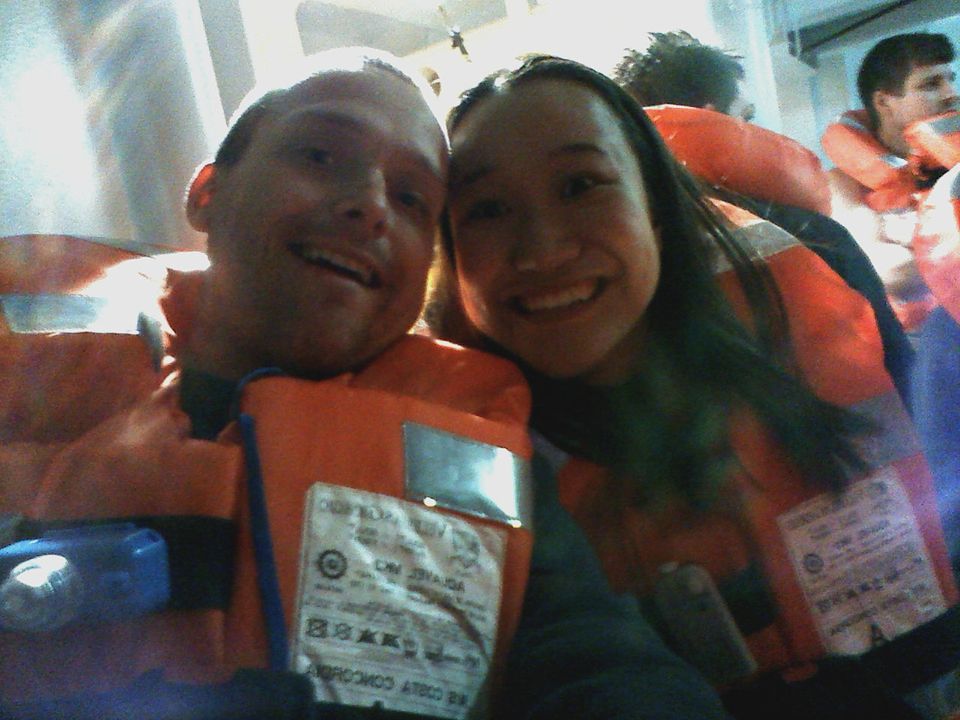
One year ago last weekend, I was on my honeymoon, walking the streets of Rome arm-in-arm with my new bride. At the end of the afternoon, as the sun was setting behind the Colosseum, we walked back up the gangplank of our cruise ship -- the Costa Concordia -- and headed back out to sea.
This was our fourth night aboard the gigantic oceanliner, and we had been expecting another night like the ones that had come before: after dinner, maybe we'd go dancing in the ballroom or see the magic show. Or maybe we'd just spend the evening relaxing with a book and listening to chamber music with a bottle of champagne.
But, as I recount in my new memoir Abandoned Ship: An Intimate Account of the Costa Concordia Shipwreck ($14.99, self published), this night would change our lives forever.
At about 9:45 that night, as we relaxed in our cabin, we heard a noise. A slow soft scratching sound came from somewhere behind us, like a pencil tip drifting across a page. We didn't know it at the time, but this was the sound of a giant rock tearing through the steel skin of the ship and leaving a hundred-foot-long gash in the hull.
On a table in our cabin, an empty wine bottle started to move, creeping inch by inch toward the edge as though possessed by a tiny, timid ghost. When it reached the precipice, it hesitated for a moment of contemplation and then tipped over the edge, thumping down on the carpet and rolling under the bed. And then, as though electrified, the whole room came to life. Books and papers slid off the desk. A paper-mache marionette I had bought in Sicily as a gift for my kids jumped from its shelf with wild eyes and flailing arms.
Something terrifying had begun. We didn't understand yet what was happening, but without a second thought, we grabbed a pair of life jackets from the closet and scrambled to the fourth deck to board the lifeboats.
But we didn't escape on the lifeboats.
After our lifeboat malfunctioned, and all the other lifeboats left us behind, we would spend the next five hours on a desperate odyssey searching for safety. We found ourselves in a nightmare labyrinth of overturned furniture, broken glass, crooked staircases, jammed doors, and inaccessible passageways. With water rushing in and time running out, we could feel the ship moving beneath us, being sucked into the sea at an accelerating pace, as though pulled toward its doom by some enormous undersea monster with ten thousand tentacles and a voracious appetite.
We had been abandoned. Left behind to die.
As the ship collapsed onto its side, the floors became walls and the walls became floors. In this surreal landscape -- under the cloak of night, with no idea how close we might be to land or whether anyone would come back to rescue us -- we struggled to survive. Amid the chaos and the screams, we scavenged a rope and rappelled down the outer hull of the ship toward the water-line. We would stay there for the next three hours, clinging to the rope and waving at passing helicopters until a lifeboat finally returned for us.
But our harrowing experience didn't end there.
When we finally reached dry land, with nothing but the clothes on our backs, we reached out to the American Embassy for help. More than 100 American citizens were on that boat, and none of us had eaten a meal for at least 16 hours. None of us had changed clothes since the evacuation, and a few people still had wet clothing and shoes from swimming to the shore. No one had undergone a physical or psychological exam. With no passports, no phones, no money, no local friends, no Italian language skills, and no idea how we'd get home, we asked for help from our country.
Ultimately, that help never materialized.
Not from the embassy anyhow.
We relied on the kindness of strangers: an innkeeper in Giglio who gave away all his rooms and all his beds, and emptied his cabinets to care for us on the night of the shipwreck. A hotel manager in Rome who took us in and gave us free room and board for the next three days. Friends of friends who hugged us and comforted us, and then took us to a doctor and helped us file a police report.
When we finally got home, we were already suffering from the first stages of post-traumatic stress disorder. We had nightmares every night, and we found it impossible to focus on our work during the day. Sometimes we cried for no reason, and sometimes we forgot to eat or sleep. But we found an excellent trauma therapist who helped guide us through the healing process and helped us make meaning from this tragedy.
And that's really what I want to talk about today.
A few months after the shipwreck, after we had been through six weeks of therapy, the psychologist asked us to consider the question: what does this tragedy mean to you?
At first, we had no answer to this question.
The shipwreck was an accident. It didn't mean anything.
But then I started writing a book about our escape from the Costa Concordia, and my wife -- classical singer and composer Emily Lau -- started working on an album of new compositions inspired by the shipwreck events.
And by engaging in that creative process, we embarked on a whole new journey.
As I began putting words down on a page, I started to find patterns and themes and symbols all around us. As I began writing our story, I found a whole universe of latent meaning hidden in the events of this catastrophe. The process of storytelling had opened up a world of significance for me.
Likewise, as Emily composed and recorded the music for her new album Isle of Lucidity, she finally faced her fears and found the stregth to forgive. The act of creative expression had given voice to the maelstrom of emotions we had experienced during the initial trauma, and by expressing those emotions in song, she could finally overcome them in her everyday life.
We were shocked to discover that our physical journey had become a spiritual journey, and we eventually came to view the shipwreck as an opportunity to create something beautiful from the ashes of disaster.
Through stories and songs, we hope to share our experiences with the world, and we believe this unique story can provide inspiration to people all over the world who suffer their own disasters and labor to regain a sense of purpose and hope.
That's what the shipwreck means to us now.
See Benji and Emily:
